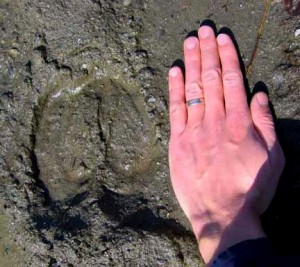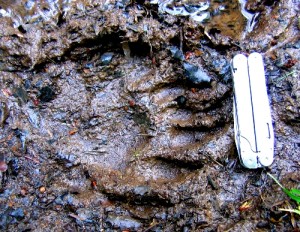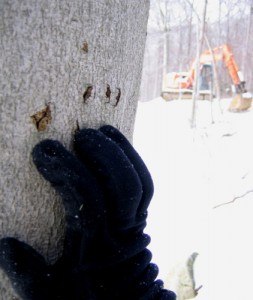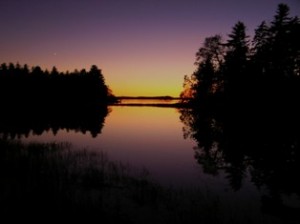The photographs, projected onto a screen in front of the room, were astonishing.
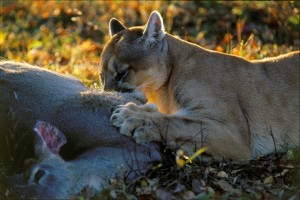
A bobcat crouching in thick cover. A cougar staring intently, its head dusted in snow. A black bear on its hind feet, marking a white birch.
And the words that went with them—spoken by wildlife biologist, conservationist, photographer, and tracker Sue Morse—were inspiring.
I had never heard anyone speak so passionately about the importance of habitat protection, particularly the danger of habitat fragmentation and the need to protect the travel corridors that keep wildlife populations interconnected and genetically viable.
She concluded the public presentation with yet another stunning photo of a bobcat.
“These are our neighbors,” she said.
A year later, while taking part in a habitat stewardship training designed and taught by Sue, I learned that she was a deer hunter.
What?
Sue loved wild animals. She admired them. She spent the vast majority of her waking hours working to understand and protect them. Keeping Track, the organization she founded, was working to conserve tens of thousands of acres of vital wildlife habitat across North America. How could she then turn around and kill one of them? It did not compute.
Only years later, as the possibility of hunting bubbled up into my own consciousness, did it begin to make sense. Only now, asking Sue about it, have I really begun to understand.
It turns out that she didn’t grow up hunting either.
It wasn’t until her early forties, she tells me, that she recognized a basic disconnect: what she calls her “schizophrenia” about predation. Carnivores were the focus of most of her research. When she came across signs of a mammalian predator’s successful hunt—perhaps a place where she could track a bobcat’s stealthy movements in the snow and read the story’s end in scattered turkey feathers—she celebrated, knowing the animal had survived another day.
A meat-eater, Sue had been raising lambs for years. She detested the cruelties and ecological impacts of the meat industry, and valued having a personal connection with the flesh foods she consumed.
Yet she wasn’t participating in the forest life cycles she studied.
It was, she decided, time to start.
Now, after more than twenty years as a predator, Sue’s message as a hunter is inextricably bound to her message as a naturalist and conservationist.
She wants to see some changes in American hunting.
Recent trends in the portrayal of hunting in television shows and videos, for instance, get under her skin. She sees far too much emphasis on competition, on success in bagging animals—in short, on killing. She sees far too little room left over for cherishing and respecting animals, for pausing to reflect on the meaning of hunting and killing, for allowing sorrow to coexist with gratitude and elation.
Sue, a hunter education instructor, feels it’s important for thoughtful hunters to address these things: “We have a huge responsibility to share with our non-hunting neighbors the truth about what hunting can and should be.”
But Sue has a more serious gauntlet to throw down.
“Many hunters,” as she once put it, “fail miserably at championing conservation and environmental protection causes.”
She’s well acquainted with the role that hunter-conservationists have played in the history of North American wildlife conservation, and with the programs funded by the license fees and excise taxes that hunters pay today. But she doesn’t think we should sit around congratulating ourselves.
Today’s dangers are too real and urgent.
Human activity continues to drive species over the brink of extinction, diminishing global biodiversity. In the United States alone, Sue notes, 3,000 acres of habitat are destroyed every day.
And we’re doing next to nothing about acid rain: “The Clean Air act hasn’t been strong enough after all, and the incalculable tons of filth we pump into the air do indeed fall back down upon us. Meanwhile our lakes and fish are poisoned, mercury contamination dictates that we shouldn’t eat our catch, and our forests sicken and decline in ways we can sadly measure but not fully understand.”
More hunters, Sue says, need to give back to the land. More hunters need to join organizations fighting to conserve wildlife habitat. More hunters need to work at building people’s awareness of the preciousness of all life, from invertebrates to wolves and cougars.
It’s vital, she argues, for hunters to join forces with environmentalists. We can’t afford political divisiveness.
Too often, she says, a few outspoken hunters “dominate the agenda, often opposing conservation measures, with their over-simplified and often selfish interests.” Too many hunters are distracted by what she calls “our increasing fascination with the machismo of bigger trucks, and the ease of mechanized hunting on ATVs and snowmobiles.”
Too many hunters miss the big picture: good hunting—like good birding, good hiking, and good berry-picking—has to begin with clean air, clean water, healthy soil, and intact ecosystems.
“We, of all people,” she told me recently, “really should get it. We should understand the relationship between a healthy natural environment and what makes us whole.”
Thanks, Sue, for all you do to keep the world whole. And for providing such a fine example of what hunting can be.
Notes: Sue’s organization Keeping Track, like so many non-profits, is struggling to keep afloat in these tough financial times; every donation, no matter how modest, helps. Also, Sue’s work with youth is profiled in the book The Woods Scientist, for kids age 9-12.
© 2010 Tovar Cerulli

